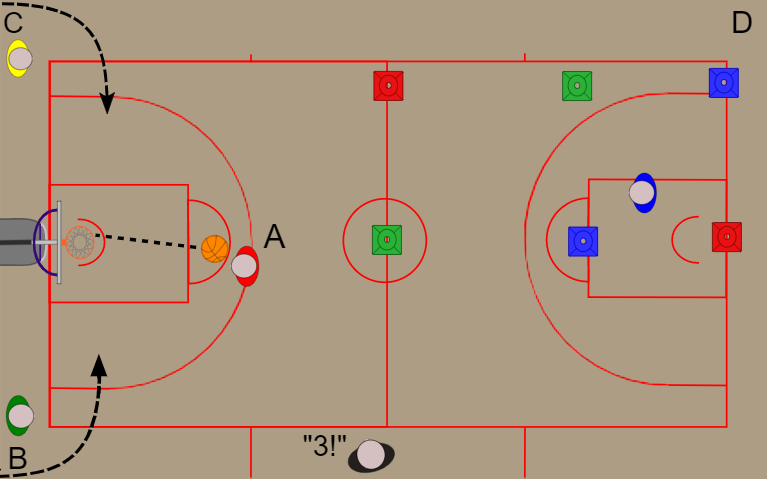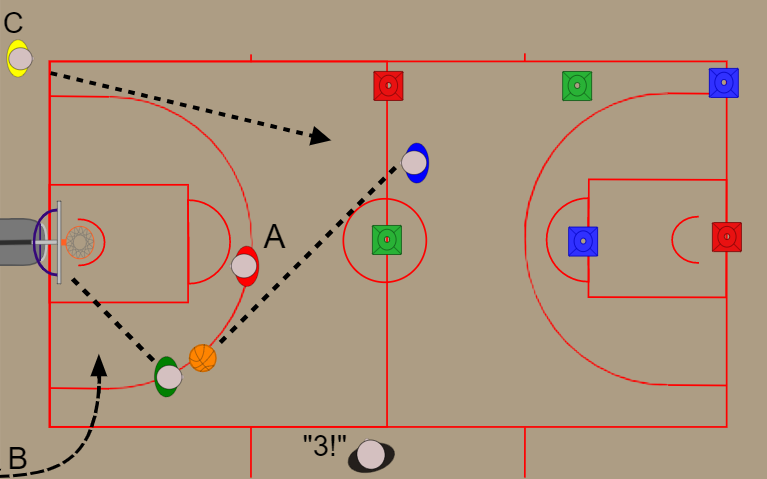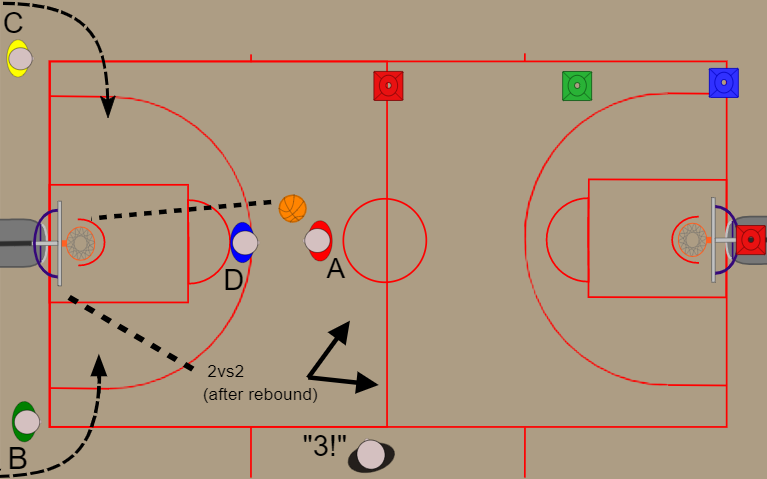EXPLANATION OF THE ROUTINE
The routine consists of varies fundamental movement skills, such as jumping & landing. In this routine the players are going to attack and defend and perform jump landing skills within three different levels.
PREPARATION
- Square field (e.g. basketball half or full court)
- 2 boxes
- 1 ball
- 1 circle (or selected material to define the task-area)
- 2 pieces of any other equipment that helps to perform jumping and landing exercises
EXECUTION OF THE ROUTINE
In this routine, the primary context is a basketball court where basketball coaches regularly perform the practice sessions at a club. The routine can be used as warming-up for different types of goals in basketball (i.e. make space dribbling, fake movements, defending, attacking, scoring, etc.).
ADDITIONAL INFORMATION: HOW DO WE REACH OPTIMAL MOTOR LEARNING AND APPLY SELF-DETERMINATION?
- Decision making will stimulate adaptive motor control: Multidirectional skills in an open unpredictable environment are incorporated, defender/attackers must anticipate/react depending on quick changes in the environment (e.g. other players, cone color change, ball).
- Implicit motor learning: Players will need to pay attention to the constantly changing environment and implicit learning is stimulated with the analogies/external focus examples of instructions/feedback to improve body posture while performing jump landing tasks.
- Challenge/Fun: Beating the opponent (challenge) to collect a winning point (fun/gamification by making this a game: most scored points, best performed jumps, chosen for most difficult jumps).
- Motivation: Enhanced by providing autonomy and replicating various realistic in game situations (tasks, goals, scores, defender/attacker) stimulating a safe challenge between players (e.g.: give a point when successfully defended will increase the competition between players).
- Autonomy: Make the players choose or control different aspect of the play (e.g.: role attacker/defender, which jumps or landing to do).
- Competence: Feeling of competence is created by giving the player option to choose a variation of the routine (by means of level or material).
- Relatedness: Feeling of relatedness is created by the sport specificity with their peers + by feeling most related by which option they have chosen from.
- Differentiation (age/difficulty): The routine is made in order to be easily adapted by the coach for various players ‘needs.
POSSIBLE VARIATIONS
- Make ‘moving optimally’ a game. That means player A and/or D can get points by landing correctly (in terms of landing technique for the prevention goal – coach will observe).
- Adding time pressure: whoever/which team scores most goals (point) within that time?
- Use different balls (players can choose from e.g. a basketball, handball, tennis ball).
- We suggest enhancing the challenge also to award points with a good rebound (before that the ball hit for the first time the ground). This challenges the players to perform landings in unexpected situations with time pressure.
- From bottom line position players B & C are facing each other while performing jumping/landing movements, this can be with or with our boxes.
- Players B and C can get inside the court and fight for the rebound when player A leaves the task area (yellow circle) in order to perform a jump shot.
- Player A can start the in-game situation whenever he/she would like.
- Player A can dribble freely in the yellow task-area (coach can define the task-area with a common tape, in order to have no interference with the game) while paying attention to players B and C.
- Players B and C are performing jumping-landing movements, this can be anything like squat jumps, jump lunges, skater jumps, rotational jumps, varying landing on one or two legs.
- Players B and C can decide which jump-landing type they’ll do and when they enter in the field to rebound the ball after their jump-landing task.
- As soon as player B or C runs into the field, player A can stop balling and can perform the jump shot.
- Players B and C rebound the ball before it hits the ground, which will create a jump-landing task.
- After the rebound (for example player C receives a rebound), the player who collects the ball must make has to make a decision who is his teammate for the next play (in this case A or B) and pass the ball to that player (let’s say A). After the pass player C must run to the three point line and receive the pass from A. Then, A and C play 2 on 1 against player B. After the play is finished players move to the initial positions of exercise in clockwise manner.
- Player A can dribble freely in the designated area (coach can define the task-area with a common tape, or use actual lines of the court) while paying attention to players B and C who are performing jump and landing exercises. Player D acts as defender to player A.
- Player B and C perform different jump-landing movements at their starting position before going to rebound the ball into the field.
- Player B (or C) replicates jumping/landing movements from players (B&C) at the bottom line: i.e. player B initiates the jump-landing movements and C mimics what B is doing. For B this creates autonomy/fun: he can decide what jump-landing to perform! For C now the jump-landing become unanticipated.
- B initiates when the jump-landing movements are finished and initiates entering the field.
- As soon as players B or C run into the field, player A can dribble to designated area and performs the jump shot.
- Players B and C fight for the rebound.
- After the rebound, the player who collects the ball (let’s say C) must make a pass to the player of his choice (A, D or B) and run towards opposite basket. Player who received the ball (let’s say A) must make long pass the player C. Other two players must adjust to be defenders. After receiving (preferably receiving while jumping) the players C dribbles the ball back to the initial basket and play 2 on 2 against D and B.



